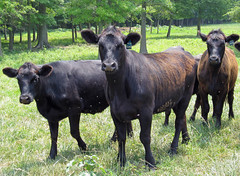 Sheep and cattle grazed paddocks alternately for 32, 96, or 192 days over 2 years. Pastureland (21 acres) was subdivided into six areas of 8 paddocks each to produce an 8-paddock rotational grazing system. Each paddock was grazed for four days and then rested for 28 days.
Sheep and cattle grazed paddocks alternately for 32, 96, or 192 days over 2 years. Pastureland (21 acres) was subdivided into six areas of 8 paddocks each to produce an 8-paddock rotational grazing system. Each paddock was grazed for four days and then rested for 28 days.Sixty-six (66) Ile de France ewes and 12 steers were randomly assigned to three groups. There were 22 sheep and 4 cattle per grazing group. Each grazing system included a cattle area and a sheep area. Sheep and cattle interchanged areas every 32, 96, or 192 days.
Fecal examination and larvae counting on pasture were performed every 32 days. During the summers, tracer lambs free of nematode infection were introduced into each sheep group and later sacrificed for quantification and identification of GIN larvae. Cattle were sacrificed for the same purpose.
Pasture contamination by sheep-infective GIN larvae was considerably reduced after 96 or 192 days of cattle grazing. Cross-infections between sheep and cattle GIN were not significant which suggests that integrated grazing of sheep and cattle could be used for pasture decontamination.
However, decontamination was not sufficient to prevent GIN infection in Ile de France sheep (a susceptible breed).
Source: Small Ruminant Research Journal, March 2008.
